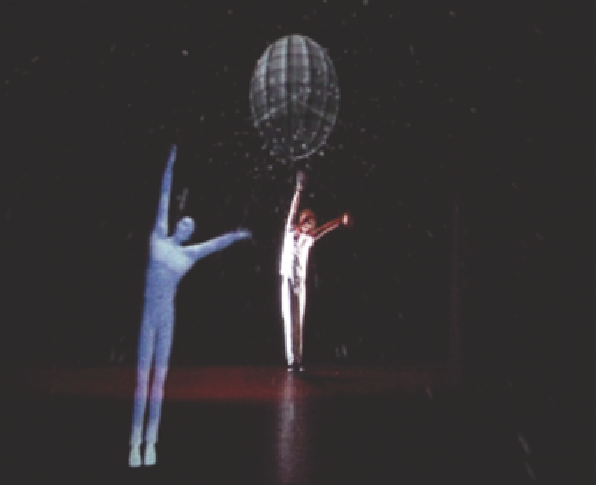Graphics Programs Reference
In-Depth Information
Figure 5. The live and avatar actor virtual dance routine
The
final piece
involved a giant avatar of a
T-Rex, which dramatically filled the stage. A live
performer entered and called out 'Rex' much
like calling to a pet dog. The projected T-Rex
subsequently appeared and approached the actor
(Figure 6). After some verbal coaching from the
performer, the T-Rex sat as a dog would follow
instructions from its owner. The T-Rex then began
to become overtly excited, jumping up and down
bringing down a virtual lighting rig (created to
mimic the actual rig in the theatre) resulting in
the actor rapidly exiting. One of the key ways
of integrating the T-Rex with the actor was to
program the T-Rex to swing its tail around in a
360 degree sweep and have the actor duck at the
opportune time. This gave the illusion of the two
being connected by the same action creating a
sense of cause and effect between avatar and actor.
The twenty-one students enrolled in the course
were invited to complete an anonymous online
questionnaire at the conclusion of the semester.
This questionnaire included questions aimed at
identifying students' familiarity with and use of
Web 2.0 and 3D virtual world technologies, and
to assess the extent to which the
Second Life
platform of delivery was perceived by students
to support the objectives of the course and enhance
their learning. The questionnaire included a mix
of Likert-scale (5 point scale ranging from 1
strongly disagree to 5 strongly agree) and open-
ended text field questions. The results from this
evaluation are reported in the next section.
Results
Fourteen students (66.7%) responded to the evalu-
ation; of those 7 (50%) were male and 7 (50%)
female. The ages of the fourteen students ranged
between 19 and 24 years. All respondents had
computers and broadband access at home and
stated they use the computer at home frequently
or often. Yet despite fitting the profile of Prensky's
(2001) 'digital native' population (those born
after 1982), 9 (64.3%) students stated they never
use online multi-user games with the remaining
5 students (26.7%) stating they rarely use these

Search WWH ::

Custom Search